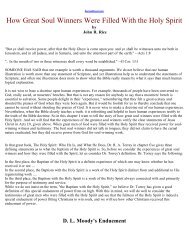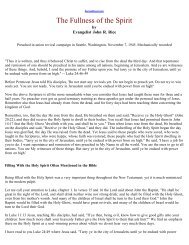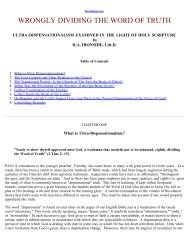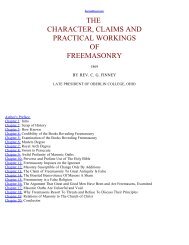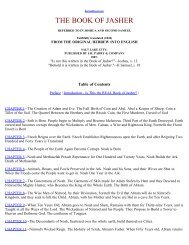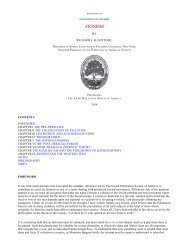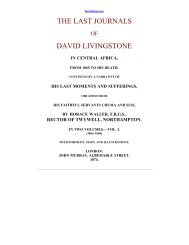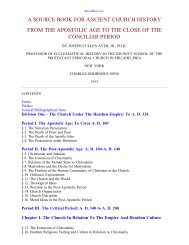Legends of Babylon and Egypt in Relation to Hebrew Tradition.pdf
Legends of Babylon and Egypt in Relation to Hebrew Tradition.pdf
Legends of Babylon and Egypt in Relation to Hebrew Tradition.pdf
You also want an ePaper? Increase the reach of your titles
YUMPU automatically turns print PDFs into web optimized ePapers that Google loves.
[1] In Semitic-<strong>Babylon</strong>ian the first component <strong>of</strong> this city-name would read "Dûr".<br />
The completion <strong>of</strong> the sentence, <strong>in</strong> the last two l<strong>in</strong>es <strong>of</strong> the column, cannot be rendered with any certa<strong>in</strong>ty, but the<br />
passage appears <strong>to</strong> have related the creation <strong>of</strong> small rivers <strong>and</strong> pools. It will be noted that the l<strong>in</strong>es which conta<strong>in</strong> the<br />
names <strong>of</strong> the five cities <strong>and</strong> their patron gods[1] form a long explana<strong>to</strong>ry parenthesis, the preced<strong>in</strong>g l<strong>in</strong>e be<strong>in</strong>g repeated<br />
after their enumeration.<br />
[1] The precise mean<strong>in</strong>g <strong>of</strong> the sign-group here provisionally rendered "div<strong>in</strong>e ruler" is not yet ascerta<strong>in</strong>ed.<br />
As the first <strong>of</strong> the series <strong>of</strong> five cities <strong>of</strong> Eridu, the seat <strong>of</strong> Nudimmud or Enki, who was the third <strong>of</strong> the creat<strong>in</strong>g<br />
deities, it has been urged that the upper part <strong>of</strong> the Second Column must have <strong>in</strong>cluded an account <strong>of</strong> the found<strong>in</strong>g <strong>of</strong><br />
Erech, the city <strong>of</strong> Anu, <strong>and</strong> <strong>of</strong> Nippur, Enlil's city.[1] But the numbered sequence <strong>of</strong> the cities would be difficult <strong>to</strong><br />
reconcile with the earlier creation <strong>of</strong> other cities <strong>in</strong> the text, <strong>and</strong> the mention <strong>of</strong> Eridu as the first city <strong>to</strong> be created<br />
would be quite <strong>in</strong> accord with its great age <strong>and</strong> peculiarly sacred character as a cult-centre. Moreover the evidence <strong>of</strong><br />
the Sumerian Dynastic List is def<strong>in</strong>itely aga<strong>in</strong>st any claim <strong>of</strong> Erech <strong>to</strong> Antediluvian existence. For when the hegemony<br />
passed from the first Post-diluvian "k<strong>in</strong>gdom" <strong>to</strong> the second, it went not <strong>to</strong> Erech but <strong>to</strong> the shr<strong>in</strong>e Eanna, which gave<br />
its name <strong>to</strong> the second "k<strong>in</strong>gdom"; <strong>and</strong> the city itself was apparently not founded before the reign <strong>of</strong> Enmerkar, the<br />
second occupant <strong>of</strong> the throne, who is the first <strong>to</strong> be given the title "K<strong>in</strong>g <strong>of</strong> Erech". This conclusion with regard <strong>to</strong><br />
Erech <strong>in</strong>cidentally disposes <strong>of</strong> the arguments for Nippur's Antediluvian rank <strong>in</strong> primitive Sumerian tradition, which<br />
have been founded on the order <strong>of</strong> the cities mentioned at the beg<strong>in</strong>n<strong>in</strong>g <strong>of</strong> the later Sumerian myth <strong>of</strong> Creation.[2] The<br />
evidence we thus obta<strong>in</strong> that the early Sumerians themselves regarded Eridu as the first city <strong>in</strong> the world <strong>to</strong> be created,<br />
<strong>in</strong>creases the hope that future excavation at Abu Shahra<strong>in</strong> may reveal Sumerian rema<strong>in</strong>s <strong>of</strong> periods which, from an<br />
archaeological st<strong>and</strong>po<strong>in</strong>t, must still be regarded as prehis<strong>to</strong>ric.<br />
[1] Cf. Poebel, op. cit., p. 41.<br />
[2] The city <strong>of</strong> Nippur does not occur among the first four "k<strong>in</strong>gdoms" <strong>of</strong> the Sumerian Dynastic List; but we may<br />
probably assume that it was the seat <strong>of</strong> at least one early "k<strong>in</strong>gdom", <strong>in</strong> consequence <strong>of</strong> which Enlil, its city-god,<br />
atta<strong>in</strong>ed his later pre-em<strong>in</strong>ent rank <strong>in</strong> the Sumerian pantheon.<br />
It is noteworthy that no human rulers are mentioned <strong>in</strong> connexion with Eridu <strong>and</strong> the other four Antediluvian cities;<br />
<strong>and</strong> Ziusudu, the hero <strong>of</strong> the s<strong>to</strong>ry, is apparently the only mortal whose name occurred <strong>in</strong> our text. But its author's<br />
pr<strong>in</strong>cipal subject is the Deluge, <strong>and</strong> the preced<strong>in</strong>g his<strong>to</strong>ry <strong>of</strong> the world is clearly not given <strong>in</strong> detail, but is merely<br />
summarized. In view <strong>of</strong> the obviously abbreviated form <strong>of</strong> the narrative, <strong>of</strong> which we have already noted strik<strong>in</strong>g<br />
evidence <strong>in</strong> its account <strong>of</strong> the Creation, we may conclude that <strong>in</strong> the fuller form <strong>of</strong> the tradition the cities were also<br />
assigned human rulers, each one the representative <strong>of</strong> his city-god. These would correspond <strong>to</strong> the Antediluvian<br />
dynasty <strong>of</strong> Berossus, the last member <strong>of</strong> which was Xisuthros, the later counterpart <strong>of</strong> Ziusudu.<br />
In support <strong>of</strong> the exclusion <strong>of</strong> Nippur <strong>and</strong> Erech from the myth, it will be noted that the second city <strong>in</strong> the list is not<br />
Adab,[1] which was probably the pr<strong>in</strong>cipal seat <strong>of</strong> the goddess N<strong>in</strong>kharsagga, the fourth <strong>of</strong> the creat<strong>in</strong>g deities. The<br />
names <strong>of</strong> both deity <strong>and</strong> city <strong>in</strong> that l<strong>in</strong>e are strange <strong>to</strong> us. Larak, the third city <strong>in</strong> the series, is <strong>of</strong> greater <strong>in</strong>terest, for it<br />
is clearly Larankha, which accord<strong>in</strong>g <strong>to</strong> Berossus was the seat <strong>of</strong> the eighth <strong>and</strong> n<strong>in</strong>th <strong>of</strong> his Antediluvian k<strong>in</strong>gs. In<br />
commercial documents <strong>of</strong> the Persian period, which have been found dur<strong>in</strong>g the excavations at Nippur, Larak is<br />
described as ly<strong>in</strong>g "on the bank <strong>of</strong> the old Tigris", a phrase which must be taken as referr<strong>in</strong>g <strong>to</strong> the Shatt el-Hai, <strong>in</strong><br />
view <strong>of</strong> the situation <strong>of</strong> Lagash <strong>and</strong> other early cities upon it or <strong>in</strong> its immediate neighbourhood. The site <strong>of</strong> the city<br />
should perhaps be sought on the upper course <strong>of</strong> the stream, where it tends <strong>to</strong> approach Nippur. It would thus have la<strong>in</strong><br />
<strong>in</strong> the neighbourhood <strong>of</strong> Bismâya, the site <strong>of</strong> Adab. Like Adab, Lagash, Shuruppak, <strong>and</strong> other early Sumerian cities, it<br />
was probably destroyed <strong>and</strong> deserted at a very early period, though it was reoccupied under its old name <strong>in</strong> Neo-<br />
<strong>Babylon</strong>ian or Persian times. Its early disappearance from <strong>Babylon</strong>ian his<strong>to</strong>ry perhaps <strong>in</strong> part accounts for our own<br />
unfamiliarity with Pabilkharsag, its city-god, unless we may regard the name as a variant from <strong>of</strong> Pabilsag; but it is<br />
hardly likely that the two should be identified.<br />
[1] The site <strong>of</strong> Adab, now marked by the mounds <strong>of</strong> Bismâya, was partially excavated by an expedition sent out <strong>in</strong><br />
1903 by the University <strong>of</strong> Chicago, <strong>and</strong> has provided valuable material for the study <strong>of</strong> the earliest Sumerian period;<br />
see /Reports <strong>of</strong> the Expedition <strong>of</strong> the Oriental Exploration Fund/ (<strong>Babylon</strong>ian Section <strong>of</strong> the University <strong>of</strong> Chicago),



